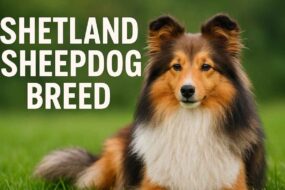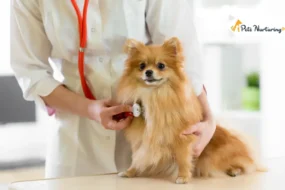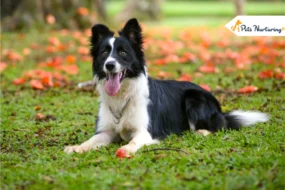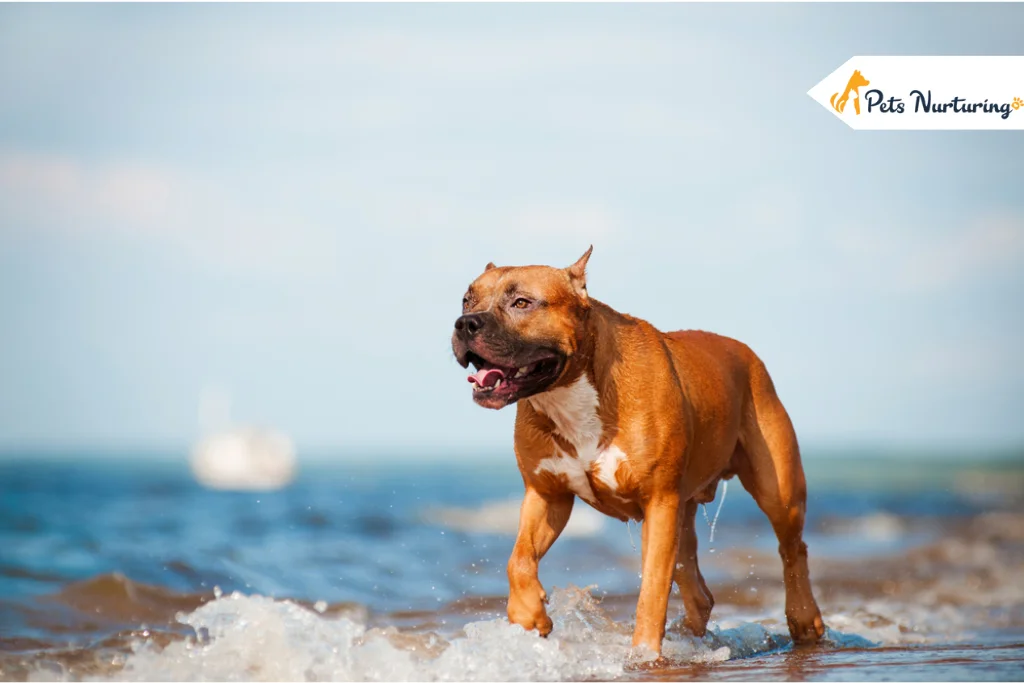
Every dog is different, so it is important to consider their needs before you bring them home. For instance – while some dogs are good for apartments, others need a house with a proper backyard. If you are considering getting an American Staffordshire Terrier, you will get all the information here.
In this guide, we are going to cover everything about the breed – from its history and characteristics to nutritional needs and grooming. The AmStaff is a loving and loyal dog that enjoys spending time with its human family.
When you raise them with love and proper training, they grow up to be gentle and obedient pets.
To know about this amazing dog breed, keep reading.
Breed Overview
The American Staffordshire Terrier is a medium-to-large dog breed originating from the United States. They are commonly known as Am Staff.
Despite its powerful build, this breed is recognized for its loving and loyal nature. Contrary to its rugged appearance and historical background, it’s actually quite gentle in temperament.
American Staffordshire Terrier Overview
Breed Group: Terrier
Height: 17 to 19 inches
Weight: 40 to 70 pounds
Lifespan: 12 to 16 years
Coat: Short and smooth
Color: Various, including brindle, blue, fawn, and black
Temperament: Loving, loyal, protective, and affectionate
Grooming Needs: Low maintenance
Hypoallergenic: No
Origin: United States
History
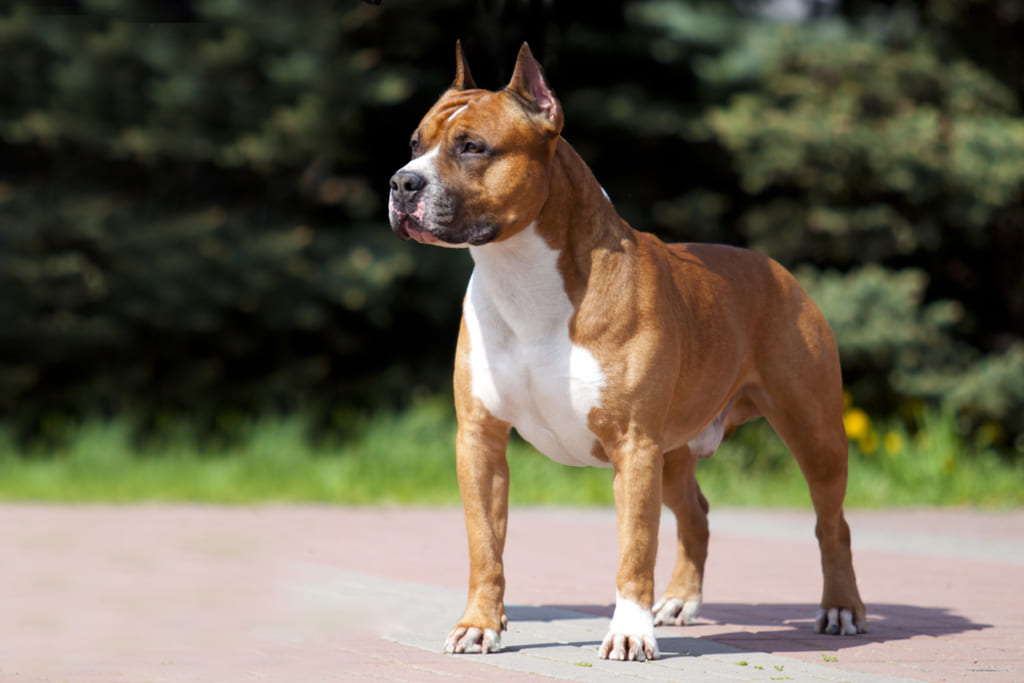
The American Staffordshire Terrier has its origins in 18th and 19th century England. During this time, bulldogs and terriers were often used in cruel blood sports.
These dogs were selectively bred for traits like energy, strength, and agility. The British Staffordshire Bull Terrier is a mix of these breeds. By the mid-1800s, these dogs made their way to the United States.
They were initially called Staffordshire Terriers because their ancestors came from Staffordshire, England. American breeders then developed a larger version known as the American Staffordshire Terrier.
On January 1, 1969, the breed’s name was changed to American Staffordshire Terrier. It was distinct from its British counterpart, with a more friendly and calm demeanor.
Since then, Am Staffs have become a fixture in American culture. They have appeared in media and even served in the armed forces. The American Kennel Club officially recognized the breed in 1936.
The AKC allowed UKC dogs to register in the AmStaff Stud Book a few times until the 1970s. Since then, both parents needed AKC registration for their offspring to be registered.
Breed selection focused solely on conformation and established breed standards. This shaped the American Staffordshire Terrier into a distinct breed from the American Pit Bull Terrier over decades.
Appearance
The AmStaff appears strong for its size. They are medium-sized, with males around 18 to 19 inches and females around 17 to 18 inches in height.
Males weigh around 55 to 70 pounds, and females around 40 to 55 pounds. There is a clear size difference between the genders.
| Characteristic | Male | Female |
| Height | 18 to 19 inches | 17 to 18 inches |
| Weight | 55 to 70 pounds | 40 to 55 pounds |
Body
Their bodies are solidly built, reflecting their strength and athleticism. Despite their muscular body, they maintain a balanced and proportional appearance.
Head
The head of an AmStaff is of medium size. It features a broad skull that adds to its powerful appearance. Strong cheek muscles contribute to their distinct facial structure.
Nose
The nose of an American Staffordshire Terrier is always black in color. This provides a striking contrast against their coat.
Eyes
Typically, AmStaffs have dark-colored eyes. Although occasionally, they may have blue eyes.
Legs
Their legs are straight and muscular. This provides them with the agility and strength needed for various physical activities.
Tail
The tail of an American Staffordshire Terrier is short compared to the rest of their body. This tail shape complements their overall appearance.
Coat and Color
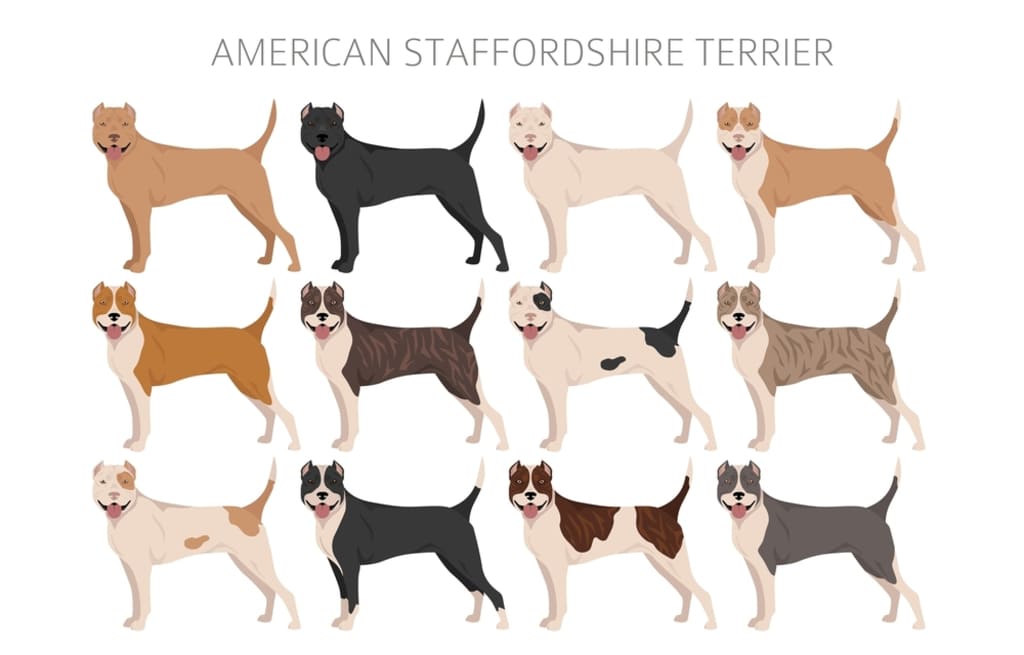
AmStaffs have short and smooth coats. This makes them very low maintenance. They do not have an undercoat, making grooming relatively simple.
American Staffordshire Terriers come in various coat colors, including:
- Liver
- Sable
- Brindle
- Brown
These colors may also have white markings on their heads and chests. However, dogs with liver or black-and-tan coats, as well as those with more than 80% white, are discouraged according to breed standards.
Temperament:
The AmStaff has a history associated with dog fighting. Despite this negative reputation, many individuals and families have discovered that AmStaffs make wonderful and versatile companions. They excel in various dog sports and activities.
AmStaffs are intelligent dogs and respond well to training. However, due to their size and energy, they need a handler who can keep them mentally and physically engaged.
It’s essential to provide them with ample opportunities for exercise, training, and mental stimulation. A short walk or basic training class won’t suffice for these active dogs. Given their needs and energy levels, first-time dog owners might want to consider other breeds better suited to their lifestyle.
The American Kennel Club describes American Staffordshire Terrier temperament as confident, intelligent, and friendly. They are known for their bravery and can be loyal and dependable friends.
American Staffordshire Terrier puppy can be great companion and are good with children. But they tend to have a lively play style. Due to their robust build, they may be overwhelming for smaller children.
Their size and strength can also make them pull strongly on leashes if not trained properly. It’s important to supervise children when interacting with any dog breed.
AmStaffs require daily exercise and mental stimulation to prevent boredom. Boredom can lead to destructive behaviors like chewing on shoes or furniture. Providing plenty of chew toys is essential.
Their energetic nature and strong bodies make them well-suited for activities like dock diving or agility games. They have also excelled in search and rescue operations due to their resilience.
AmStaffs tend to bark, especially when bored or left alone for long periods. It’s important to train them to offer alternative behaviors, such as going to their mat, to manage excessive barking.
| Characteristic | Level |
| Friendliness | Moderate |
| Affection Level | High |
| Friendly with Pets | Moderate |
| Friendly with Kids | Moderate |
| Playfulness | Moderate |
| Exercise Needs | Moderate |
| Energy Level | Moderate |
| Intelligence | Moderate |
| Trainability | Moderate |
| Amount of Shedding | Moderate |
| Tendency to Bark | Moderate |
Health and Nutrition
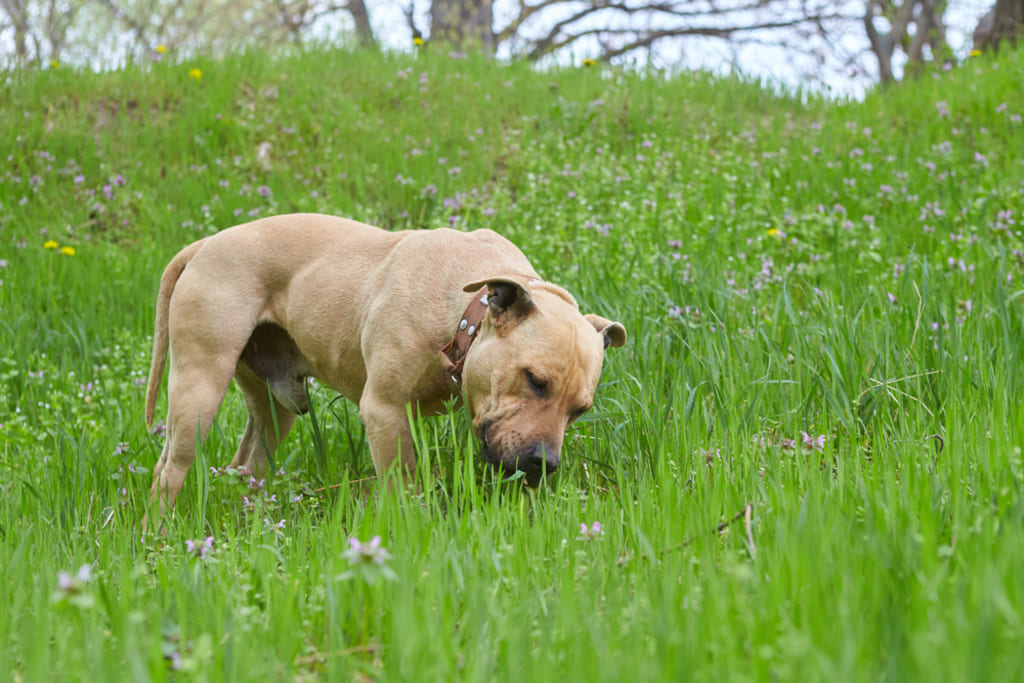
What to Feed American Staffordshire Terrier
AmStaffs may be small in size, but they’re considered large breed dogs. Look for a balanced diet rich in protein from meat, along with essential vitamins and minerals.
When choosing food, opt for options that meet the standards set by the Association of American Feed Control Officials (AAFCO) for your dog’s life stage. Consulting with your vet is wise, especially considering your dog’s activity level and any health issues they may have.
Feeding Routine
For American Staffordshire Terrier puppies, split their meals into at least three portions a day. As they mature into adults, you can transition to feeding twice a day. Stick to this routine even as they reach their senior years.
Portion Control
Commercial diets typically provide feeding guidelines on the packaging, which is a good starting point. For homemade diets, calculate the calorie content per meal and adjust it based on your dog’s needs. Consider their activity level. Younger, more active dogs require more food than older or less active ones.
Nutritional Advice
American Staffordshire Terrier puppies are prone to joint problems. Supplement their diet with joint-supportive ingredients like – glucosamine and chondroitin.
Omega-3 fatty acids are beneficial for joint health, as well as promoting healthy skin and coat. Check if your dog’s diet already contains these, or consider supplementing with chews or oils.
Treats
To keep your dog healthy, limit treats to just 10% of their daily calorie intake. Select treats suitable for their size and health requirements.
Water
Make sure your dog has access to fresh water. Change the water twice a day.
Common Health Problems
American Staffordshire Terriers usually live 12 to 16 years and are generally healthy dogs. However, they can be prone to a few issues as they age.
Elbow Dysplasia
Elbow dysplasia is a genetic condition causing joint problems in the elbows of large-breed dogs. Similar to hip dysplasia, it can appear in young American Staffordshire puppies.
Pet owners should be alert for limping in their dog’s front legs, especially after exercise. Treatment involves anti-inflammatory medication and physical therapy. Surgery may be necessary for severe cases.
Hip Dysplasia
Hip dysplasia is a genetic condition where the hip joint doesn’t form correctly. It can cause mild discomfort or severe pain and difficulty moving. Veterinarians diagnose it using X-rays.
It is often detected when dogs are 1 to 2 years old. Pain management with NSAIDs can help, but treatment depends on how severe the condition is.
Cerebellar Ataxia
Cerebellar ataxia is a hereditary neurological disorder found in American Staffordshire Terriers. Symptoms usually start between 3 to 6 years old. They include balance problems, stiffness in movement, head tremors, and fast eye movements. Sadly, there’s no cure for this disease, and most affected dogs are put to sleep as their condition worsens.
Progressive Retinal Atrophy (PRA)
American Staffordshire Terrier puppy may develop a hereditary condition known as progressive retinal atrophy (PRA). It causes gradual blindness.
PRA can begin in puppyhood but typically affects adult AmStaffs. It often starts with difficulty seeing in low-light conditions. While PRA doesn’t cause pain, there’s no cure for it.
Food and Skin Allergies
American Staffordshire Terriers may develop allergies to food or their surroundings. Usually, a brief course of antibiotics can help clear up the infection. However, to prevent further skin and stomach problems, AmStaffs might need to switch to a hypoallergenic diet.
Hypothyroidism
Hypothyroidism happens when the thyroid gland doesn’t make enough thyroxine hormone. This issue often appears in dogs aged 4 to 10 years. The good news is that hypothyroidism can be managed with medication.
Behavior and Training
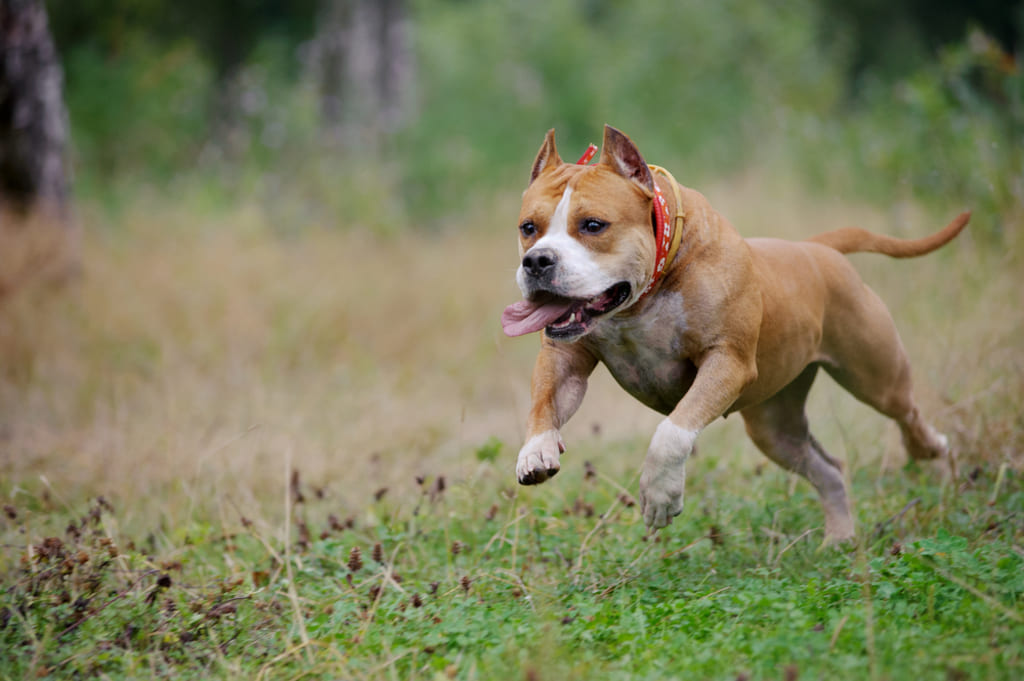
American Staffordshire Terriers are energetic dogs that thrive with at least an hour of vigorous exercise each day. They are affectionate towards their family but may be reserved around strangers. Socialization from a young age is crucial to help them feel more comfortable with new people and situations.
With proper socialization, AmStaffs can coexist with other pets. But their strong prey drive means introductions should be carefully managed. They are patient with children, but supervision is necessary during interactions.
AmStaffs may experience anxiety, particularly separation anxiety. Consistent training and a structured routine can help manage this. Providing ample attention, exercise, and mental stimulation can also alleviate anxiety.
While they may bark at unfamiliar sounds, AmStaffs are generally quiet enough for apartment living. Although AmStaffs can be stubborn, they are eager to please and quick learners. Consistent training is key to maintaining their attention. Verbal commands and hand signals can be effective training tools.
Incorporating physical activities like agility training or playing fetch can keep them engaged and satisfied. Toys can also help fulfill their need for mental stimulation and exercise.
Exercise Needs
American Staffordshire Terriers have a moderate energy level. They need about 1 to 2 hours of exercise every day. This can include walks, playing fetch, jogs, and other active games. Puzzle toys are also great for keeping them mentally busy.
You can also make them participate in dog sports. However, it’s important to be careful not to overexert them in hot weather, as they can be sensitive to heat.
Some of their favorite games include:
- Tug of war
- Running through agility courses
- Playing with jolly balls
- Chasing after balls
Grooming Needs
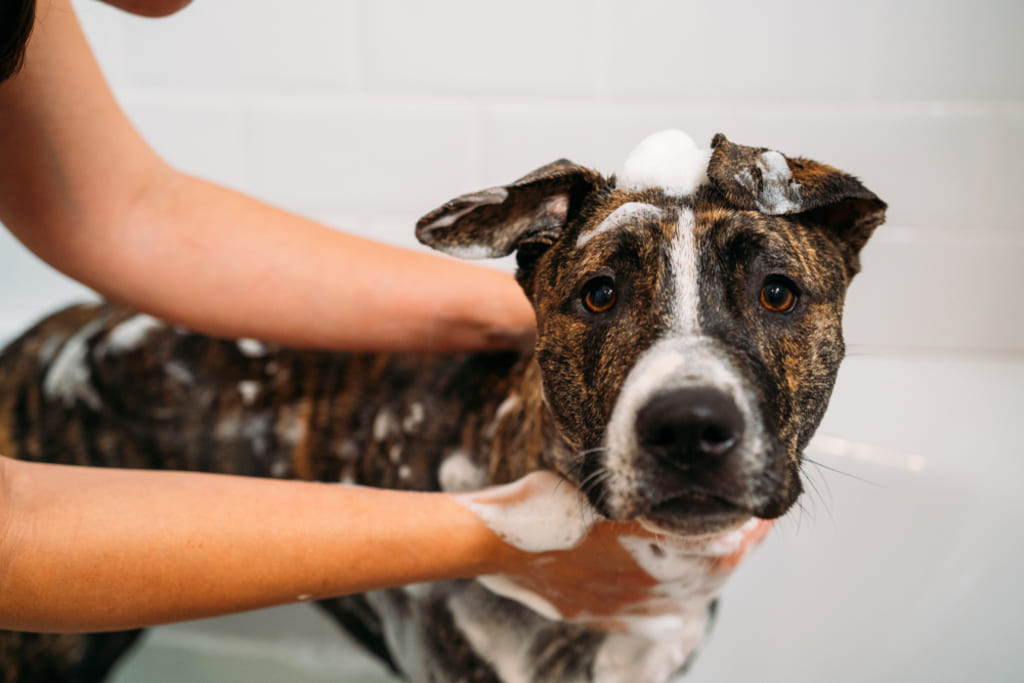
Grooming an AmStaff is simple due to their short coat. Brushing them every few weeks is sufficient to manage sheddings.
Skin Care
AmStaffs may have sensitive skin, so it’s best to keep grooming simple. Bathe them no more than every 4 to 6 weeks with a pet-friendly shampoo. Omega-3 fatty acid supplements can also help maintain healthy skin and coat.
Coat Care
Their short coat is easy to maintain and rarely mats. While frequent brushing isn’t necessary, a quick once-over every few weeks can help keep their coat clean.
Teeth Care
Regular dental care is important for AmStaffs. Provide dental chews or toys to help reduce tartar buildup, and consider brushing their teeth regularly with a pet-safe toothpaste and toothbrush.
Eye Care
Watch out for a condition called distichiasis. Here, abnormal hair grows from the eyelid toward the eye and causes irritation. Lubricants can provide relief, but surgery may be necessary in severe cases.
Nail Care
Keep your AmStaff’s nails trimmed to a comfortable length, as overgrown nails can cause discomfort or affect their gait. Trim them every 1 to 2 months or as needed.
Ear Care
Clean your AmStaff’s ears during baths every 4 to 6 weeks. This is especially important if there’s a buildup of debris. Consult your vet if you notice any concerning symptoms.
Are American Staffordshire Terriers Hypoallergenic?
No, American Staffordshire Terriers are not hypoallergenic dogs. While they do shed their fur occasionally, they produce very little dander. So, if you have allergies, make sure you spend some time with the breed to see if they cause any symptoms.
Price of an AmStaff
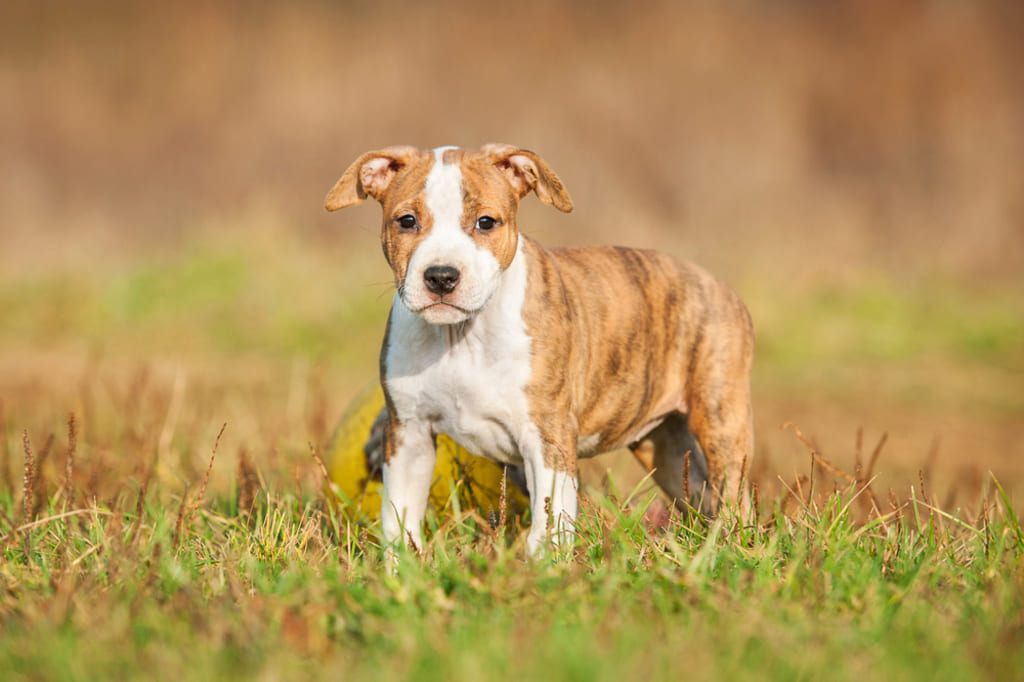
American Staffordshire Terrier for sale can cost anywhere between $1,500 and $3,000 in the U.S. The average price is around $2,000.
The price of an American Staffordshire Terrier for sale can also differ based on various factors like the breeder’s reputation, the puppy’s bloodline, and color.
An AmStaff named Bud joined America’s initial cross-country road journey in 1903.
American Staffordshire Terrier Life Span
On average, the American Staffordshire Terrier’s life span is between 12 and 16 years. Compared to other medium-sized dogs, they are generally healthy and live up to a long age. Regular visits to the vet can often help them live even longer, sometimes up to 16 years.
FAQs
There’s no recognized breed called a pit bull, but there’s an American Pit Bull Terrier. Both the breeds are quite similar. When it comes to American Staffordshire Terrier vs Pitbull, the main difference is in their size. AmStaffs follow a stricter size standard, while Pit Bulls can vary more in size and appearance.
Yes, American Staffordshire Terriers can be good family dogs with proper training and socialization.
Behavior problems in Staffies may include – aggression toward other animals, separation anxiety, and excessive barking.
Yes, Staffies can show signs of jealousy, especially in situations where they feel they are not receiving enough attention.
Conclusion
Before making a decision about whether the American Staffordshire Terrier is the right dog for you, it’s important to do thorough research. Our guide will offer you all the necessary information about the breed. You can also talk to other owners of Am Staffs to gather more information.
These dogs have a bad reputation due to their history of being used in fights. However, they make really good pets and can even live with kids and other pets. With proper training and socialization, you will get a loving and affectionate friend for life.
Keep Reading:








